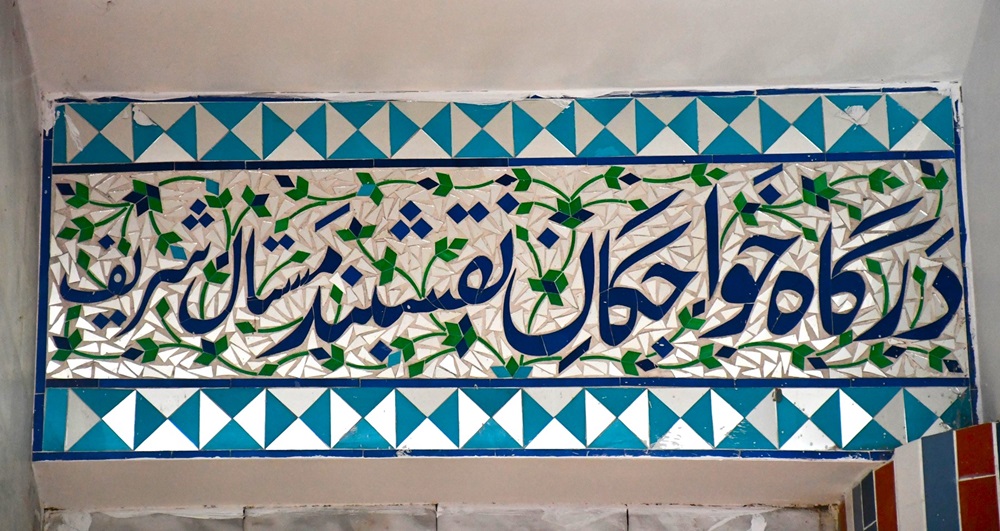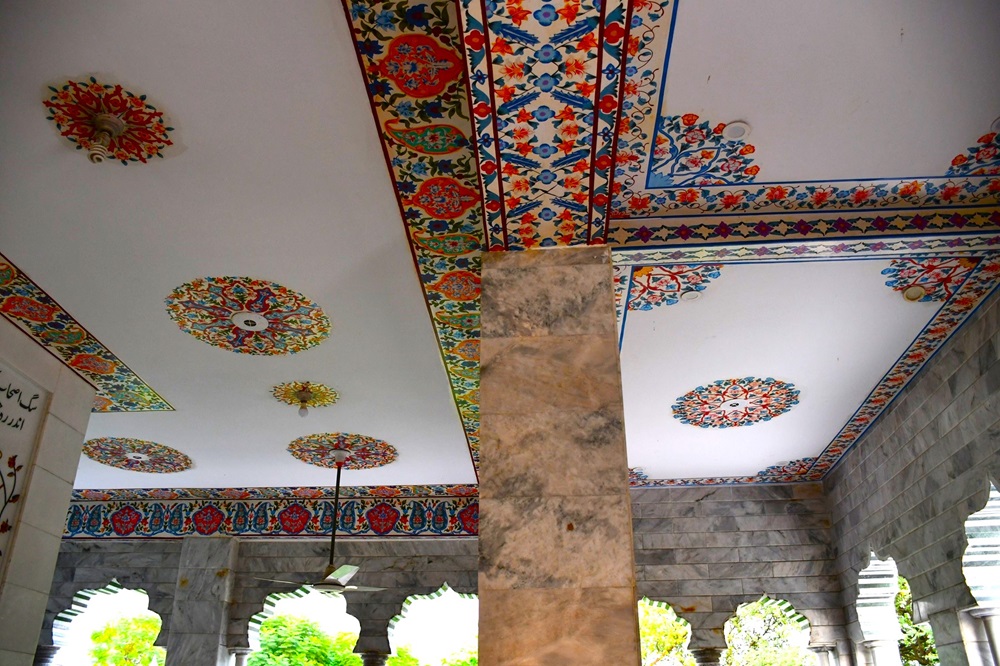Written by: Zulfiqar Ali Kalhoro
Posted on: March 07, 2025 |  | 中文
| 中文
Graves of Khwaja Abdul Ali Naqshbandi and Khwaja Muhammad Amin Naqshbandi. (Picture credits to Zulfiqar Ali Kalhoro)
Mastal Sharif is home to a historic shrine complex, one of the oldest in the capital city of Islamabad, with origins that predate the city itself. Before Islamabad was designated as the capital of Pakistan, Mastal Sharif was a vibrant village in the Rawalpindi district, rich in culture and history. As Islamabad began to expand and modernize, the Capital Development Authority (CDA) initiated a series of developments that led to the relocation of many residents from Mastal Sharif to make way for new urban sectors. This transformation marked a significant shift in the community's landscape, yet the spiritual essence of the place endured. Today, the only remaining shrine in Mastal Sharif is dedicated to Khwaja Muhammad Amin Naqsnbandi Mastalvi, a revered figure whose legacy is cherished by many. This shrine is situated in the old village area, now located in Sector H-10 of Islamabad. Khwaja Muhammad Amin, known for his piety, was the son of Khwaja Shaikh Ahmad Ji Usmani, whose shrine is located in Chak Beli Khan’s Rupper Kalan Sharif village.
Rupper Kalan Sharif is a vibrant and thriving centre of the Naqshbandi Sufi order, founded by Khwaja Shaikh Ahmed Ji Usmani Naqshbandi. He was a deputy of Khwaja Muhammad Namadar, who himself was a deputy of Khwaja Noor Muhammad Churahi, whose shrine is located in Chura Sharif.
Chura Sharif is an important beacon of Naqshbandi teachings, located in Jand tehsil of Attock district. This historic centre has played a pivotal role in shaping the spiritual lives of many Sufi practitioners and scholars. It was here that countless devotees received the initiation into the Naqshbandiyya silsila.

Dargah Khwajgan-e-Naqshband, Mastal Sharif. (Picture credits to Zulfiqar Ali Kalhoro) (Picture credits to Zulfiqar Ali Kalhoro)
Inspired by their experiences at Chura Sharif, many initiated individuals went on to establish their own religious centres in various villages and towns throughout Pothohar and beyond, further disseminating the teachings of the Naqshbandiyya Silsila and fostering a deep sense of community and spirituality across the region.
One learns from Gujar Khan Ke Suhrawardi Mashaikh by Hasan Nawaz Shah (2013:42) that Khwaja Shaikh Ahmad Ji Usmani came to Gujar Khan’s Bher Ratial village, where he met Khwaja Muhammad Namdar for the first time there. It was there that he was initiated into Naqshbandiyya Silsila by Khwaja Muhammad Namdar. After getting a robe of initiation (Khirqa) from Khwaja Muhammad Namdar, Khwaja Shaikh Ahmad Ji Usmani established his khanqah in Rupper Kalan Sharif and started preaching the Naqshbandiyya Silsila. Khwaja Shaikh Ahmed Ji Usmani's three sons: Khwaja Faqir Muhammad Usmani, Khwaja Habibullah and Khwaja Muhammad Amin continued his legacy. Khwaja Faqir Muhammad Usmani and Khwaja Habibullah Usmani stayed in Rupper Kalan Sharif, whereas on the instruction of his father, Khwaja Muhammad Amin went to Mastal village in Rawalpindi (now in Islamabad territory) to spread Naqshbandiyya Silsila. Khwaja Muhammad Amin continued to preach in Mastal Sharif, and many people enrolled themselves as his disciples. Like his brothers, he was also an avid reader and author of two books. He also possessed a rare collection of books on Sufism, theology and other subjects.
Khwaja Shaikh Ahmed Ji Usmani passed away in 1868 and was interred in Rupper Kalan Sharif. Khwaja Muhammad Amin Mastalvi remained in Mastal Sharif to continue his father’s legacy, ultimately establishing it as the permanent centre of his preaching activities.
On August 6, 2023, I visited the Khwaja Muhammad Amin shrine complex and met with Pir Mazhar Hussain, the Sajjada Nashin of the shrine. During our interview, he shared the history of the Mastal Sharif shrine. According to him, Khwaja Muhammad Amin had friendly relationships with several Sufi saints of his time, including the renowned Chishti saint Pir Mehar Ali Shah Golarvi (d. 1937). Khwaja Muhammad Amin had many followers whom he frequently visited. He dedicated his entire life to preaching and reading, and a rare collection of books in his library showcases his literary taste and indicates how well-read he was.

Pir Mazhar Hussain, Sajjada Nashin of Mastal Sharif Darbar. (Picture credits to Zulfiqar Ali Kalhoro)
Khwaja Muhammad Amin died in 1901, leaving behind two sons, Khwaja Abdul Hayee and Khwaja Muhammad Abdul Ali. Maqsood Ahmad Sabiri (2003:108) states in Tazkira Auliya-e-Pothohar that Khwaja Abdul Hayee went to perform Hajj but fell ill and died in Makkah. Khwaja Muhammad Abdul Ali became the Sajjada Nashin of the Darbar of Khwaja Muhammad Amin. He was also a highly learned scholar and continued to preach the Naqshbandiyya Silsila. Many people became his disciples, and he expanded the library by acquiring rare books. He died in 1943 and was laid to rest beside his father. His son, Sahibzada Muhammad Aghar Ali Naqshbandi, succeeded him. He was also a celebrated Naqshbandi saint of Mastal Sharif, who upheld the legacy of their ancestor and died in 1991. He, too, was buried in Mastal Sharif. The grave of Khwaja Muhammad Amin's wife also lies within his tomb. It also contains the graves of his descendants. There are also several graves outside the tomb of Khwaja Muhammad Amin.
The tomb of Khwaja Muhammad Amin Mastalvi is among the most impressive structures in Islamabad. Upon entering the tomb, one notices the name Panj Ganj Naqshband inscribed on the façade of the shrine's portico, which is also renowned for its exquisite inlay work and painting. The tomb is adorned with marble slabs, and one can also observe paintings in the tomb of Khwaja Muhammad Amin. All renovation and maintenance work is being carried out by the current Sajjada Nashin, Pir Mazhar Hussain. Adjacent to the tomb is a mosque whose minaret is visible from a distance. Beside the tomb are the hujra (room) of Khwaja Muhammad Abdul Ali and a library that was initially established by Khwaja Muhammad Amin. I visited the library, and Pir Zafar Hussain kindly gifted me one of the books authored by Khwaja Muhammad Amin.

Painting in the tomb of Khwaja Muhammad Amin at Mastal Sharif. (Picture credits to Zulfiqar Ali Kalhoro)
The disciples of Khwaja Muhammad Amin reside in various villages and towns of Pothohar. Those who live in different sectors and housing schemes display the name Mastal Sharif on their vehicles, indicating that they were once residents of the historic Mastal Sharif village.
The writer is an anthropologist. He has authored 17 books on Pakistan's cultural heritage and anthropology. He tweets @kalhorozulfiqar. He may be contacted at zulfi04@hotmail.com
You may also like: